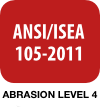Portwest A520 PRemium Tig Welding Gauntlet
The Portwest A520 is the ultimate in dexterity for welders. Soft, flexible goatskin palm with heavy duty split leather cuff. For use in type B (Tig Welding). Stitching made from para-aramid throughout.



EN 420, EN 388, EN 12477
Product Technical Information
Standards
- EN ISO 21420: 2020
- EN 388: 2016 + A1: 2018 2221X
- EN 12477: 2001 Type B
- EN 407: 2020 413X3X
Documentation
Protective Gloves : General Requirements
EN420 : 2003 + A1 2009
This standard defines the general requirements for glove design and construction, innocuousness, cleaning instructions, electrostatic properties, sizing, dexterity, water vapour transmission and absorption along with marking and information
EN 388
Gloves giving protection from mechanical risks
Protection against mechanical hazards is expressed by a pictogram followed by four numbers (performance levels), each representing test performance against a specific hazard.
1 Resistance to abrasion
Based on the number of cycles required to abrade through the sample glove (abrasion by sandpaper under a stipulated pressure). The protection factor is then indicated on a scale from 1 to 4 depending on how many revolutions are required to make a hole in the material. The higher the number, the better the glove. See table below.
2 Blade cut resistance
Based on the number of cycles required to cut through the sample at a constant speed. The protection factor is then indicated on a scale from 1 to 4.
3 Tear resistance
Based on the amount of force required to tear the sample.
The protection factor is then indicated on a scale from 1 to 4.
4 Puncture resistance
Based on the amount of force required to pierce the sample with a standard sized point. The protection factor is then indicated on a scale from 1 to 4.

Protective Gloves For Welders
EN 12477: 2001
This European standard specifies requirements and test methods for protective gloves for use in manual metal welding, cutting and allied processes. According to their performance, protective gloves for Welders are classified into two types.
Type A: lower dexterity (with higher other performance).
Type B: Higher dexterity (with lower other performance).